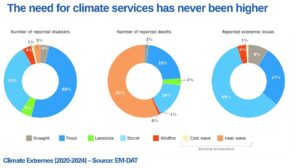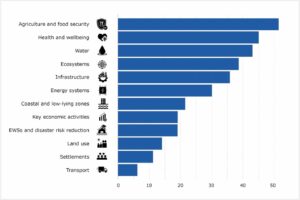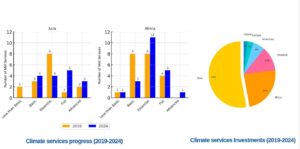According to a multi-agency flagship report produced by the World Meteorological Organization (WMO), large gaps remain in the provision of this climate information for decision-making, and investment lags far behind needs.
The State of Climate Services report found that in 2024, one-third of national meteorological and hydrological services (NMHS) provide climate services at an ‘essential’ level, and nearly one-third at an ‘advanced’ or ‘full’ level. It said that countries in Asia and Africa, in particular, have made strides in boosting their capacity thanks to targeted adaptation funding.
“On our journey toward sustainable development, we need to do more to turn climate science and climate information into actionable services, to make climate services more accessible and to use them more effectively,” said WMO secretary-general Celeste Saulo. “In the face of unprecedented environmental challenges, the development, delivery and use of climate information to enable climate action has never been more crucial.”
The report also highlighted that 2023 was the warmest year on record, with the unprecedented warmth continuing into 2024. Many climate extremes are reportedly becoming more frequent and intense. While weather- and climate-related reported deaths are decreasing over time due to better early warnings and disaster risk management, economic losses are increasing.
In the period from 2020 to mid-2024, floods remained the most frequently reported disaster. However, heat-related hazards became the leading cause of death, accounting for 57% of the total reported weather-, water- and climate-related deaths globally. Storms resulted in the greatest economic losses, contributing to 59% of the total, according to data from the EM-DAT international disaster database cited in the report.

Credit: EM-DAT
Of the US$63bn being spent on climate adaptation, nearly a third goes toward climate-informed investments, with a small portion (estimated at about US$4-5bn) of that explicitly supporting climate services and early warning activities, according to the report.
However, despite an overall increase, the report notes that the continued investment is not necessarily translating into support for building the capacities of national meteorological and hydrological services, which are essential organizations for supporting climate action at the national and local level through the provision of climate information services. Latin America and the Caribbean, for instance, face a growing need for early warning services to deal with hazards such as forest fires and droughts.
“We need to make the necessary investments for a sustainable future. The cost of no action is several times higher than the cost of action. This is why it is essential to increase support for NMHS for collecting better knowledge of Earth’s system and its changes, delivering fit-for-purpose climate services to support decision-making, and developing early warning systems to protect communities from increasing natural hazards,” said Saulo.
Collecting annual reports on climate services
WMO has issued annual reports on the state of climate services for the past five years. This is in response to a request from the UN Framework Convention on Climate Change Conference of the Parties (COP) for more information on adaptation needs and to help identify steps needed to address climate service gaps and needs to inform more effective investment. All climate action investments need to be climate-informed so that they are forward-looking – the past is no longer indicative of the future.
The latest edition of the report explores the current state of play and also documents the progress that has been made in the last five years. It includes analyses and stories to explain how specific countries, including Seychelles, Mauritius, Laos and Ireland, have succeeded in developing and using climate services to deliver a range of socio-economic benefits and to advance climate action.
The report is based on contributions from 38 partners including major climate finance institutions, such as the Green Climate Fund, Adaptation Fund and the Global Environment Facility, which are founding partners of the report series, and the UNFCCC Secretariat. The UN Office for Disaster Risk Reduction worked closely with WMO on the investment section of this year’s edition.
WMO will present the State of Climate Services 2024 report at COP29 in Baku, Azerbaijan. It complements the UN Environment Programme’s Adaptation Gap report, published on the same day.
Research highlights
The report found that the need and demand for climate services to inform decision-making has never been higher. It also highlighted that there is a growing awareness and commitment to incorporating climate services into national adaptation plans (NAP). More than 80% of the 58 countries that have submitted a NAP acknowledged and recognized the importance of climate services as part of their national adaptation strategies, according to UNFCCC.

Additionally, the research found that there has been substantial progress in terms of climate service capacity in the last five years – especially in Asia and Africa. The number of NMHS providing ‘advanced’ climate services increased from eight in 2019 to 15 in 2024. There is a clear trend toward a higher level of sophistication and comprehensiveness in these services, allowing society to more effectively tackle climate challenges and opportunities through climate-informed decisions.

Despite progress, gaps remain
However, according to the WMO, too few nations are creating tailored climate services, and there are still significant gaps in the coverage of observing networks in Least Developed Countries (LDCs) and Small Island Developing States (SIDS), for instance. Less than 20% of NMHSs reported that they have conducted socioeconomic benefit (SEB) assessments of their weather, climate and hydrological services over the last 10 years.
The report also found significant gaps in the co-development of climate services that recognize the specific impacts of climate-related risks for children, women, people with disabilities and marginalized social and livelihood groups. Further, the engagement of children and youth as key partners in the co-development and inclusive communication of climate services has apparently not yet been addressed sufficiently, and education has not yet been integrated as a key sector within global and national climate services frameworks.
WMO analysis showed that the services being provided to national governments, agriculture and emergency planning and response are in highest demand. The analysis of NDCs showed increased attention to health and ecosystems and biodiversity in the context of climate change adaptation. The analysis also revealed an increase in NMHS offering climate services to all sectors since 2000, with two notable increases being in the commercial and tourism sectors.
This trend highlights growing recognition of the value climate information holds for business continuity, risk management and strategic planning. Businesses can use climate information to strategically manage their supply chains and minimize disruptions caused by extreme weather and climate events. The tourism sector needs climate information to enhance tourist well-being and to decide the location and construction scheduling for new resorts. In 2024, 62 NMHS provide data services to the tourism sector, compared with 48 in 2019.
Regional cooperation was found to be a key enabler for the successful development, delivery and use of climate services. In 2024 there are 26 designated WMO Regional Training Centres (RTCs) serving as hubs for educating and equipping NMHS personnel with the necessary skills and knowledge to develop and deliver weather, climate and hydrological services, with 143 NMHS benefiting in 2024 compared with 65 in 2019.The importance of regional cooperation is highlighted by many of the case studies included in the annex to the present report, such as the case studies for Trinidad and Tobago, Seychelles, Australia, Mauritius and Maldives, and also in 36 case studies out of the 113 collected since 2019, as part of the State of Climate Services reports.
The following organizations contributed to the 2024 edition: Adaptation Fund, Agence Française de Développement, African Development Bank, Asian Development Bank, Barbados Meteorological Services, Belgian Climate Centre, Bureau of Meteorology Australia, Climate Policy Initiative, Climate Risk and Early Warning Systems, Deloitte Belgium, Department of Meteorology, Ministry of Water Resources and Meteorology – Cambodia, Department of Meteorology and Hydrology – Lao People’s Democratic Republic, Environmental Protection Agency, Ireland, Food and Agriculture Organization of the United Nations, Global Environment Facility, Green Climate Fund, Group on Earth Observations Global Agricultural Monitoring (GEOGLAM), Inter-American Development Bank, Met Éireann – The Irish Meteorological Service, Maldives Meteorological Service, Mauritius Meteorological Services, National Institute of Meteorology and Hydrology – Ecuador, National Meteorological Service of Argentina, Philippine Atmospheric, Geophysical and Astronomical Services Administration, Save the Children, Seychelles Meteorological Authority, Systematic Observations Financing Facility, Transport Infrastructure Ireland, Trinidad and Tobago Meteorological Service, UK Met Office, United Nations Development Programme, United Nations Environment Programme, United Nations Framework Convention on Climate Change Secretariat, United Nations Office for Disaster Risk Reduction, University College Cork, University of Cambridge, World Bank and the World Meteorological Organization.
In related news, the WMO Executive Council recently approved a detailed road map to speed up and scale up efforts to ensure that early warnings cover everyone on the planet. Click here to read the full story.


